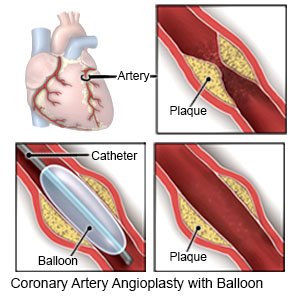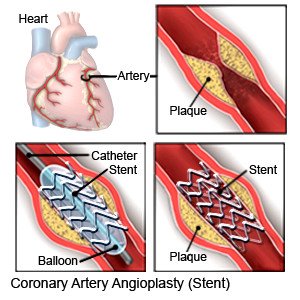Coronary Intravascular Stent Placement
Medically reviewed by Drugs.com. Last updated on Nov 3, 2024.
What do I need to know about coronary intravascular stent placement?
Coronary intravascular stent placement is a procedure to place a stent in a blocked or narrowed artery of your heart. A stent is a small mesh tube made of metal that helps keep your artery open. The procedure may be done during or after angioplasty. The stent remains in your artery for life. You may need more than one stent.
How do I prepare for my procedure?
- Your healthcare provider will tell you how to prepare for your procedure. Your provider may tell you not to eat or drink anything after midnight on the day of your procedure. Arrange to have someone drive you home when you leave the hospital.
- Tell your provider about all your current medicines. Your provider will tell you if you need to stop any medicine for the procedure and when to stop. Your provider will tell you which medicines to take or not take on the day of your procedure.
- You may be given an antibiotic to help prevent a bacterial infection. Contrast liquid may be used during your procedure. Tell a healthcare provider if you have ever had an allergic reaction to antibiotics or contrast liquid.
- You may need blood tests and a stress test before your procedure. Talk to your provider about these or other tests you may need.
What will happen during the procedure?
- You may be given an antibiotic through your IV to help prevent a bacterial infection. You will be given medicine in your IV to help you relax or make you drowsy. You will also get local anesthesia that will numb the area where the catheter will be placed (catheter site). You will be awake during the procedure so healthcare providers can give you instructions. You may be asked to cough, hold your breath, or to tell them how you feel during the procedure.
- A catheter (long, thin tube) will be put into an artery in your wrist, groin, or neck. The catheter will be gently guided through this artery to your heart and into the narrowed or blocked artery. Healthcare providers will use x-rays and contrast liquid to find the area where the stent needs to be placed. You may feel warm as the contrast liquid is put into the catheter. This feeling should go away quickly.
- A guidewire will then be placed into the catheter. The balloon catheter will be guided into the narrowed or blocked artery with the guidewire. Healthcare providers will inflate the balloon several times for short periods. The inflated balloon pushes the plaque against the artery walls. This opens them and allows more blood flow to your heart. Another balloon catheter with a stent is then inserted into the artery. The balloon is inflated. This expands the stent and pushes it into place against the artery wall.

- Your healthcare provider may place a bare metal stent or a drug-eluting stent (DES) in your artery. A DES is coated with medicine that is slowly released. The medicine helps prevent more plaque buildup. The stent will be left in your artery to help keep it open.

- The catheter and guidewire will be taken out of the artery and a pressure bandage will be put on the catheter site. Your provider may apply a collagen plug or other closure device to stop the bleeding. Healthcare providers will put pressure on the bandaged area to help stop the bleeding.
What should I expect after the procedure?
- You will be taken to a room to rest. Healthcare providers will monitor you closely for any problems. You will then be taken to your hospital room.
- You may need to lie still for 3 to 6 hours after the procedure to prevent bleeding. Do not get out of bed until your healthcare provider says it is okay. If you need to cough, use your hand to apply pressure to the catheter site.
What are the risks of the procedure?
- You may develop a hematoma (swelling caused by collection of blood). You may bleed more than expected from your catheter site. The contrast liquid used during this procedure may cause an allergic reaction or kidney problems. You may develop an infection.
- Your artery may be injured when the catheter is inserted. During or after your procedure, blood clots may form, or plaque may break off. The blood clot or plaque may block your artery and cause a heart attack or stroke. The stent could collapse, or a clot could form on the stent. This could cause the artery to become blocked again. You may need another procedure to open your artery.
Care Agreement
You have the right to help plan your care. Learn about your health condition and how it may be treated. Discuss treatment options with your healthcare providers to decide what care you want to receive. You always have the right to refuse treatment. The above information is an educational aid only. It is not intended as medical advice for individual conditions or treatments. Talk to your doctor, nurse or pharmacist before following any medical regimen to see if it is safe and effective for you.© Copyright Merative 2024 Information is for End User's use only and may not be sold, redistributed or otherwise used for commercial purposes.
Learn more about Coronary Intravascular Stent Placement
Care guides
Further information
Always consult your healthcare provider to ensure the information displayed on this page applies to your personal circumstances.
